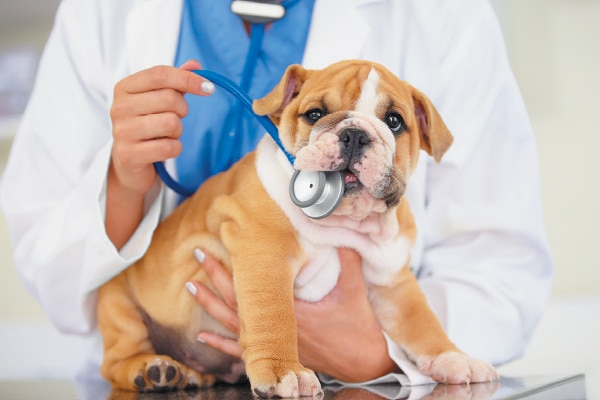Panosteitis is a disorder in puppies that causes pain in the leg bones. People sometimes use the term “growing pains” or simply “pano” to describe panosteitis (the word panosteitis means inflammation of the bones). Let’s learn more about pano in dogs and how to handle it:

When do dogs develop pano?

Pano is usually seen in puppies between the ages of 5 and 18 months old, but some puppies exhibit symptoms even earlier than 5 months of age. Once a puppy is diagnosed with pano, he might continue to experience symptoms until he’s two years old.
What are the signs of pano in dogs?
The first sign of pano in dogs is usually limping. The limping tends to seemingly come out of nowhere with no obvious injury or incident that preceded the limping. The limping also seems to “move around,” meaning that the puppy with pano will limp on one leg, then limp on another leg.
“The condition can be quite painful in the forelimbs, the hind limbs or both, and will cause limping and whining,” says Amanda Forgeng, DVM, medical director of VCA Boulevard Animal Hospital in Newport News, Virginia. “The most common bone affected is the ulna in the forelimb. On palpation of the long bones of the limbs, there will be significant pain. The final symptom that may be seen is muscle atrophy in the effected limbs.”
What causes pano in dogs?
No one really knows the cause of panosteitis. “There are several theories as to what might be the culprit,” Dr. Forgeng says. “One speculation is an infectious cause. There have been several normal dogs that have received [bone marrow] from an infected dog and they in turn develop panosteitis. Also, some dogs with panosteitis will develop a fever and an increase in their white blood cell count. Bacteria has not been cultured from this condition, but there is speculation that a virus is involved.”
Other unconfirmed theories about the cause of panosteitis include protein accumulation in the bone marrow (caused by an excess of protein in the diet) and genetics. “Since there is a breed predisposition for panosteitis (German Shepherd Dogs, Golden Retrievers, Basset Hounds, Doberman Pinschers, Labrador Retrievers and other large breeds), a valid theory is that there is a genetic component,” Dr. Forgeng explains.

How is pano in dogs diagnosed?
According to Dr. Forgeng, panosteitis is not commonly seen by general practice vets. In fact, in the 12 years she has been practicing, she’s diagnosed pano in three dogs. However, it’s possible that the condition is under-diagnosed. “X-rays are needed to confirm a diagnosis,” she explains. “Many owners who notice limping in their young dogs may associate it with an injury or a sprain, and if the clinical signs resolve, x-rays may not have been pursued.”
How is pano in dogs treated?
There is no cure for panoseitis, but in time, the condition will eventually resolve on its own when the dog outgrows it. However, because panosteitis may be extremely painful, pain control is essential. “An anti-inflammatory specific for dogs is usually the best medication for treatment,” Dr. Forgeng says.
For some dogs, anti-inflammatory drugs are not enough to control the pain, so the veterinarian might also prescribe additional pain medications. Limit exercise during flare-ups and avoid very long or strenuous exercise in general until the dog outgrows the pano entirely.
Tell us: Have you ever dealt with pano before?
Read more about dog health on Dogster.com:
- The Regional Guide to Fleas and Ticks on Dogs
- Let’s Talk Symptoms, Diagnosis and Treatment for Dog Eye Ulcers
- What Is Idiopathic Immune-Mediated Thrombocytopenia (IMT) in Dogs?
Featured Image Credit: PeopleImages | Getty Images.









